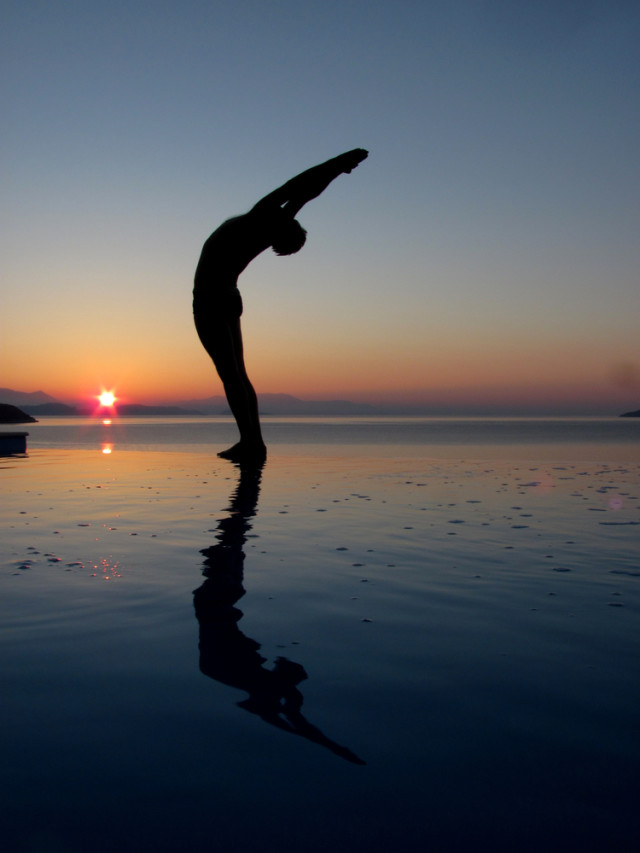
All of us have heard of Suryanamaskar (Sun Salutions) but not many know about Chandranamaskar or moon salutations. Though not as popular as Suryanamaskar, it does offer powerful benefits of its own. A sequence of 17 yoga asanas, the moon salutation is a good warm up before your yoga practice or a cool down for your evening restorative yoga session.
Difference between Suryanamaskar and Chandranamaskar :-
Moon salutation is to honor the femininity in nature. One of the key differences is that moon salutation is always done in a slow and relaxed manner. Chandranamaskar is done only 4-5 times at once unlike the Suryanamaskar which is a set of 12 rounds . In Chandranamaskar, one starts at the left and moves on to the right whereas in Suryanamaskar we start on the right side. This is because the left side represents ‘ida naadi’ ( Ida is the left channel. Ida is white, feminine, cold, represents the moon and is associated with the river Ganga (Ganges).
Originating in Muladhara or the root chakra, Ida ends up in the left nostril) which represents the moon and the right side represents the ‘pingala naadi’ which represents the sun. ( Pingala is the right channel. Pingala is red, masculine, hot, represents the sun and is associated with the river Yamuna. Originating in Muladhara, Pingala ends up in the right nostril).
Although it can be practiced at almost any time of the day, the best time would be in the evenings, around sunset or when the moon is up. The moon phases affect everything on the earth that contains two elements – salt and water.
Benefits of moon salutation: Practicing the moon salutation on days of the full moon can help balance fiery energies and calm you down if you are feeling stressed or hyper excited. It also helps channel your creative energies. The physical benefits include stretching and strengthening of the muscles of the thighs, calves, pelvis and ankles. The focus mainly remains on the lower body.
There are several variations of the moon salutation, each different from the other. What I am sharing below is a traditional form of Chandranamaskar.
Steps in Chandranamaskar or Moon Salutations:
Chandra Namaskar Sequence
1. Tadasana: Mountain pose– Stand with your feet together, body aligned with breath. Bring the palms into namaskar position, stretch the hands above the head and lengthen the spine. Stay in this position and take a few breaths before you move to the next.
2. Chandrasana: Side stretch pose- Inhale deeply and as you exhale bend to the left side. You can feel a gentle stretch on your right. Be careful to not tilt forward or back.
3. Utkata konasana: Victory squat- Return to the centre, step the feet apart and turned slightly out. Inhale and as you exhale bend your knees, bringing the thighs parallel to the ground. Keep the forearm at 90 degrees to the arms and palms facing you. It helps strengthen the back and thighs.
4. Utthita tadasana: Five pointed star- Simply raise yourself from the squatting position and straighten the elbows. Hands parallel to the ground. Relax the shoulders and chest.
5. Trikonasana: Triangle pose– Step the left foot out and slide down to the left side. Extend the right hand up. This helps improve flexibility of the spine and corrects misalignment of shoulders.
6. Parsvottanasana: Hand to knee pose- Bring the head to touch the left knee. Relax both the hands down on the left foot. This asana helps to improve posture and sense of balance. It also improves digestion and lengthens the muscles on the back of the leg.
7. Left side lunge: Bend both the knees and move into lunge on the left side. Keep looking to your left.
8. Forward facing lunge: Straighten the knee and do a forward facing lunge. Bring both the hands in front on the floor.
9. Malasana: Squat with the feet firmly on the floor and the palms joined in front of you. Maintaining your balance with the feet down and the spine extended may be a bit of challenge. ‘Mal’ in Sanskrit means impurity. Regular practice of this asana helps to improve bowel movements, hence the name.
10. Forward facing lunge: Repeat step 8 but this time bend the right knee and straighten the left.
11. Right side lunge: Bend both the knees and move into lunge on the right side. Keep looking to your right.
12. Parsvottanasana: Straighten both knees and bring your head to rest on the right knee, both hands near right foot.
13. Trikonasana – same as mentioned above
14.Utthita Tadasana – same as mentioned earlier
15. Utkata Konasana – same as mentioned earlier
16. Tiryaka Tadasana: Hands in namaskar position, extended overhead, bend to your right.
17.Tadasana: Conclude one sequence, returning to where you began.
Calm down with these asanas while surrendering to the beauty of the moon !




Leave a Reply